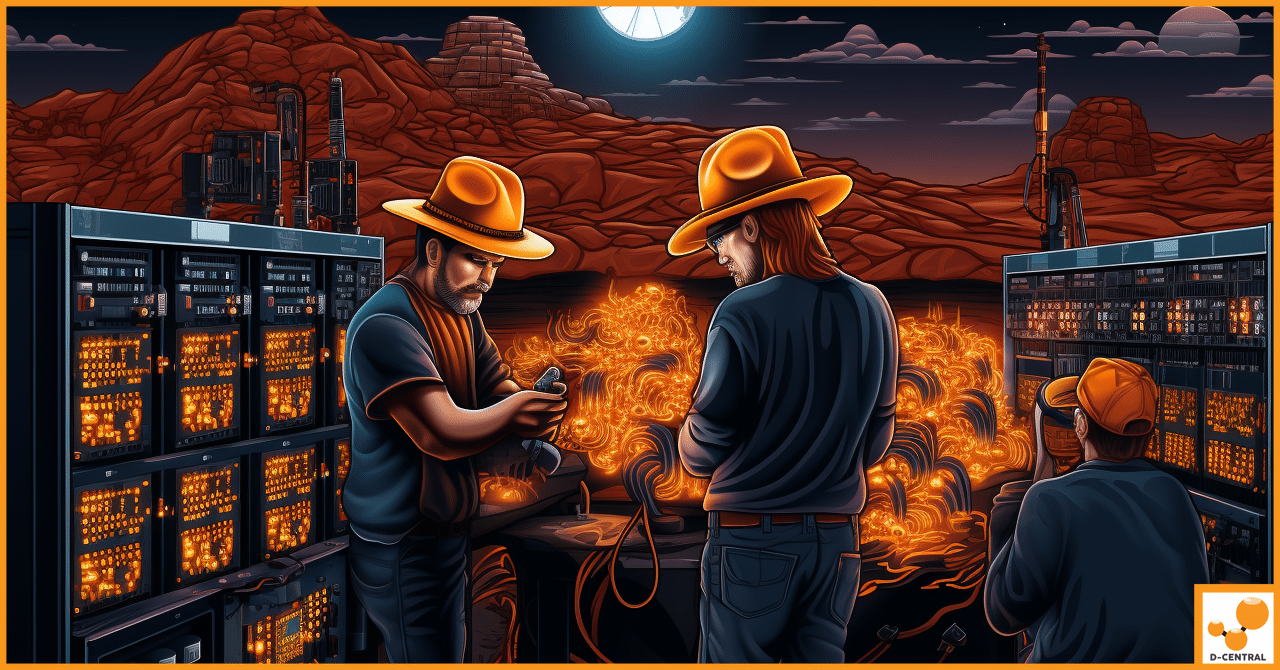
The ERCOT Ancillary Services Phenomenon: How Bitcoin Miners Are Becoming Energy Tycoons
Bitcoin mining stands as a cornerstone that not only facilitates the creation of new bitcoins but also secures the entire
4479 Desserte Nord Autoroute 440, Laval, QC H7P 6E2

Bitcoin mining is the computational process that validates and secures transactions on the Bitcoin blockchain. This process requires the use of specialized hardware such as Application-Specific Integrated Circuits (ASICs) or more commonly used graphics processing units (GPUs) in some setups. These devices solve complex cryptographic puzzles to add new blocks to the blockchain, a task that is both power-intensive and critical for maintaining the network’s integrity and security.
The energy consumption of Bitcoin mining is significant, with the global Bitcoin network estimated to use more electricity than some countries. For instance, recent studies suggest that the Bitcoin network consumes more power annually than the entire nation of Sweden. This high energy use is primarily due to the nature of proof-of-work (PoW), the consensus algorithm underlying the Bitcoin network, which requires substantial computational power and, by extension, electrical power.
This substantial energy requirement leads to considerable heat production as a byproduct. Mining hardware, particularly when densely packed in data centers, can generate enough heat to significantly increase ambient temperatures, necessitating active cooling solutions to maintain operational stability and efficiency.
The waste heat generated from Bitcoin mining has traditionally been viewed as a byproduct to be cooled and dispersed. However, innovative approaches are now redirecting this waste heat for practical use, thus turning an environmental liability into an asset. For example, in colder climates, this excess heat can be used to warm residential homes, commercial buildings, and industrial facilities, effectively reducing heating costs and carbon footprints.
The principle behind this repurposing is simple: instead of expelling the heat into the environment, it is captured using heat exchangers and redirected to heating systems. This process not only provides a necessary service but also improves the overall energy efficiency of the heating system involved.
Golf courses are typically associated with vast green spaces and leisurely sporting activities, but they also encompass facilities like clubhouses, pro shops, and maintenance buildings, all of which require heating during colder months. The concept of using Bitcoin mining to offset heating costs involves setting up mining operations within or near these facilities so that the waste heat they generate can be efficiently captured and used to heat these spaces.
Bitcoin mining is notoriously energy-intensive. This is primarily due to the need for powerful computing hardware and the continuous, intensive computational operations required to mine effectively. The total energy consumption of the Bitcoin network is comparable to that of entire countries, underscoring the massive amount of power required for its operations. The proof-of-work system, which is the underlying mechanism that facilitates mining, deliberately makes solving hash problems difficult and energy-consuming to ensure network security and integrity.
The process of mining involves billions of rapid mathematical calculations performed by mining hardware to find the correct hash for transaction block validation. These calculations generate a lot of electrical resistance, which in turn produces a significant amount of heat. For instance:
This waste heat, if not vented out through cooling systems, could damage the hardware and reduce its efficiency and lifespan. However, this same heat can be captured and repurposed, for example, to provide heating solutions for buildings, thereby turning a byproduct of mining into a beneficial resource. The implementation of this heat recovery can significantly improve the overall energy efficiency of mining operations and offer a sustainable solution to the heat waste problem.
In summary, while Bitcoin mining is a power and heat-intensive process, the potential to repurpose the waste heat presents an opportunity for innovative energy solutions, such as heating golf course facilities, which could lead to significant operational cost savings and environmental benefits.
Golf courses encompass a variety of facilities that require heating, particularly in cooler climates:
Utilizing the waste heat from Bitcoin mining offers several advantages for golf courses:
Several industries and individual enterprises have successfully implemented heat recovery systems using waste heat from Bitcoin mining, demonstrating the versatility and potential of this innovation:
These examples illustrate the practical applications of repurposing waste heat from Bitcoin mining and provide a proven framework that golf courses can adapt to meet their specific heating needs. This innovative use of an otherwise problematic byproduct of Bitcoin mining not only offers a solution to reduce operational costs but also enhances the sustainability credentials of the facilities adopting it.
Implementing a Bitcoin mining heating solution involves a detailed setup process, from selecting the right equipment to integrating the system into existing infrastructure. This section outlines the steps required to effectively harness waste heat from Bitcoin mining for heating golf course facilities.
The setup for a Bitcoin mining heating system requires strategic planning around the placement of hardware, the type of cooling and heat recovery technologies employed, and the integration into existing heating systems. The objective is to capture waste heat from Bitcoin miners and repurpose it to meet the heating needs of golf course facilities.
By carefully planning and implementing these systems, golf courses can effectively convert waste heat from Bitcoin mining into a valuable resource that reduces heating costs and enhances sustainability efforts. The integration of advanced cooling and heat transfer technologies further optimizes this process, making it a viable and innovative solution for energy management in golf course operations.
The economic viability of using Bitcoin mining as a heat source for golf courses encompasses several aspects: the setup and operational costs, potential savings compared to traditional heating methods, return on investment (ROI), and opportunities for additional revenue. Each of these factors plays a crucial role in determining the overall financial benefit of this innovative approach.
Bitcoin Mining Operations Costs:
Traditional Heating Methods Costs:
Using Bitcoin mining as a heat source could lead to substantial savings in heating costs, especially in regions with cold climates where heating needs are significant. The heat generated by miners, which would otherwise require active cooling and thus additional energy expenditure, can be redirected to heat facilities, effectively double-dipping on the energy used for mining. For instance, a study by K33 Crypto suggested that repurposing waste heat from Bitcoin mining operations could offset the need for traditional heating, reducing natural gas or electricity expenses by up to 70%.
The ROI for integrating Bitcoin mining with heating systems can be compelling:
For example, using the waste heat for district heating or greenhouse operations not only cuts down operational costs but also potentially extends the growing season, providing more indirect financial benefits.
Repurposing waste heat from Bitcoin mining offers significant environmental benefits by improving the overall energy efficiency of mining operations and reducing waste. This practice not only utilizes an otherwise discarded byproduct but also decreases the demand on heating systems that typically rely on fossil fuels.
The integration of Bitcoin mining and waste heat repurposing into golf course operations presents a compelling case for environmental stewardship and operational efficiency. By adopting such systems, facilities not only aid in pushing the envelope on renewable energy utilization but also align themselves with global efforts towards sustainability.
Utilizing Bitcoin mining to heat golf course facilities presents a novel integration of technology with traditional energy management systems. The primary benefits include significant reductions in heating costs as the waste heat from mining operations is repurposed to warm clubhouses, maintenance buildings, and greenhouses. This approach not only cuts down on fossil fuel consumption but also enhances the sustainability profile of the golf course by reducing carbon emissions and supporting renewable energy initiatives.
Moreover, the integration of technologies such as D-Central’s Antminer Space Heater Editions exemplifies the practical application of dual-purpose Bitcoin miners that can heat spaces while generating cryptocurrency, thus adding a potential revenue stream. These products, particularly the Antminer S9 and S17 Space Heater Editions, are designed to operate quietly and efficiently, making them suitable for indoor environments where noise could be a concern.
The intersection of Bitcoin mining and golf course management marks a forward-looking step towards sustainable and economically efficient operations. This integration not only promises reduced operational costs and a lower carbon footprint but also aligns with broader environmental goals and the increasing push towards technological innovation in traditional industries.
By adopting such technologies, golf courses can become pioneers in the sustainable use of cryptocurrency mining, setting a benchmark for others in the recreational and sports industry. It encourages a shift from purely profit-driven activities towards more environmentally responsible practices, potentially transforming how golf courses and similar facilities manage their energy needs.
For those interested in exploring this innovative solution for home or small-scale use, the Antminer S9 and S17 Space Heater Editions from D-Central offer a practical and efficient option. These units are specifically designed to provide heating solutions while also enabling Bitcoin mining, offering a smart integration into modern smart homes.
What is Bitcoin mining?
Bitcoin mining is the process of validating and securing transactions on the Bitcoin blockchain using specialized hardware such as ASICs or GPUs. It involves solving complex cryptographic puzzles to add new blocks to the blockchain.
Why does Bitcoin mining consume so much energy?
Bitcoin mining consumes a significant amount of energy due to the proof-of-work consensus algorithm, which requires substantial computational power to solve cryptographic puzzles. This process is energy-intensive and generates a lot of heat.
Can the waste heat from Bitcoin mining be repurposed?
Yes, the waste heat from Bitcoin mining can be repurposed for heating in various applications, such as residential homes, commercial buildings, industrial facilities, and specifically in the context of this article, golf course facilities.
How can Bitcoin mining heat be used in golf courses?
Golf courses can use the waste heat from Bitcoin mining to warm clubhouses, maintenance buildings, and greenhouses, reducing heating costs and carbon footprints while improving overall energy efficiency.
What are the environmental benefits of using Bitcoin mining waste heat?
Repurposing waste heat from Bitcoin mining reduces reliance on fossil fuel-based heating solutions, thereby decreasing carbon emissions. It also enhances energy utilization efficiency by reusing the byproduct of mining operations.
What is the D-Central’s Antminer Space Heater Edition?
The D-Central’s Antminer Space Heater Editions are specialized Bitcoin mining devices designed to operate quietly and efficiently. They can heat spaces while generating cryptocurrency, offering a dual-purpose solution that integrates technology with traditional energy management systems.
How can Bitcoin mining positively impact golf course management?
Integrating Bitcoin mining with golf course management can significantly reduce heating costs, lower carbon footprint, and support renewable energy initiatives. It aligns with global sustainability goals by making operations more environmentally friendly and economically efficient.
DISCLAIMER: D-Central Technologies and its associated content, including this blog, do not serve as financial advisors or official investment advisors. The insights and opinions shared here or by any guests featured in our content are provided purely for informational and educational purposes. Such communications should not be interpreted as financial, investment, legal, tax, or any form of specific advice. We are committed to advancing the knowledge and understanding of Bitcoin and its potential impact on society. However, we urge our community to proceed with caution and informed judgment in all related endeavors.
Related Posts

Bitcoin mining stands as a cornerstone that not only facilitates the creation of new bitcoins but also secures the entire

In this comprehensive exploration, we delve into the world of micro-mining and its potential to revolutionize Bitcoin’s mining landscape. Discover

Bitcoin, the pioneering cryptocurrency, has captivated the financial world since its inception in 2009. As the forerunner of the digital